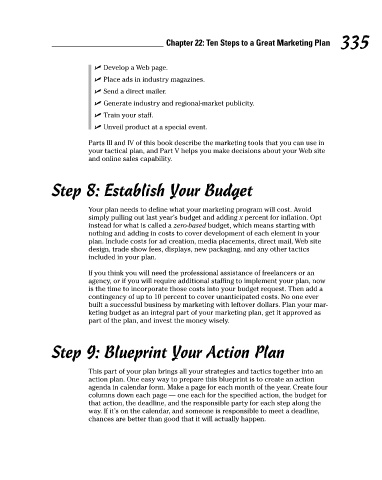Page 351 - Duct Tape Marketing
P. 351
335Chapter 22: Ten Steps to a Great Marketing Plan
ߜ Develop a Web page.
ߜ Place ads in industry magazines.
ߜ Send a direct mailer.
ߜ Generate industry and regional-market publicity.
ߜ Train your staff.
ߜ Unveil product at a special event.
Parts III and IV of this book describe the marketing tools that you can use in
your tactical plan, and Part V helps you make decisions about your Web site
and online sales capability.
Step 8: Establish Your Budget
Your plan needs to define what your marketing program will cost. Avoid
simply pulling out last year’s budget and adding x percent for inflation. Opt
instead for what is called a zero-based budget, which means starting with
nothing and adding in costs to cover development of each element in your
plan. Include costs for ad creation, media placements, direct mail, Web site
design, trade show fees, displays, new packaging, and any other tactics
included in your plan.
If you think you will need the professional assistance of freelancers or an
agency, or if you will require additional staffing to implement your plan, now
is the time to incorporate those costs into your budget request. Then add a
contingency of up to 10 percent to cover unanticipated costs. No one ever
built a successful business by marketing with leftover dollars. Plan your mar-
keting budget as an integral part of your marketing plan, get it approved as
part of the plan, and invest the money wisely.
Step 9: Blueprint Your Action Plan
This part of your plan brings all your strategies and tactics together into an
action plan. One easy way to prepare this blueprint is to create an action
agenda in calendar form. Make a page for each month of the year. Create four
columns down each page — one each for the specified action, the budget for
that action, the deadline, and the responsible party for each step along the
way. If it’s on the calendar, and someone is responsible to meet a deadline,
chances are better than good that it will actually happen.

